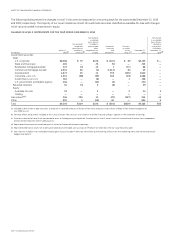GE 2010 Annual Report Download - page 117
Download and view the complete annual report
Please find page 117 of the 2010 GE annual report below. You can navigate through the pages in the report by either clicking on the pages listed below, or by using the keyword search tool below to find specific information within the annual report.
GE 2010 ANNUAL REPORT 115
indicators. The categories used within this section such as
impaired loans, troubled debt restructuring and nonaccrual
financing receivables are defined by the authoritative guidance
and we base our categorization on the related scope and defini-
tions contained in the related standards. The categories of
nonearning and delinquent are defined by us and are used in our
process for managing our financing receivables. Definitions of
these categories are provided below:
IMPAIRED LOANS are larger-balance or restructured loans for which
it is probable that the lender will be unable to collect all amounts
due according to original contractual terms of the loan agreement.
TROUBLED DEBT RESTRUCTURINGS are those loans for which we
have granted a concession to a borrower experiencing financial
difficulties where we do not receive adequate compensation.
Such loans are classified as impaired, and are individually
reviewed for specific reserves.
NONACCRUAL FINANCING RECEIVABLES are those on which we
have stopped accruing interest. We stop accruing interest at the
earlier of the time at which collection of an account becomes
doubtful or the account becomes 90 days past due. Although we
stop accruing interest in advance of payments, we recognize
interest income as cash is collected when appropriate provided
the amount does not exceed that which would have been earned
at the historical effective interest rate.
NONEARNING FINANCING RECEIVABLES are a subset of nonaccrual
financing receivables for which cash payments are not being
received or for which we are on the cost recovery method of
accounting (i.e., any payments are accounted for as a reduction of
principal). This category excludes loans purchased at a discount
(unless they have deteriorated post acquisition).
DELINQUENT FINANCING RECEIVABLES are those that are 30 days
or more past due based on their contractual terms.
The same financing receivable may meet more than one of the
definitions above. Accordingly, these categories are not mutually
exclusive and it is possible for a particular loan to meet the defini-
tions of a TDR, impaired loan, nonaccrual loan and nonearning
loan and be included in each of these categories in the tables that
follow. The categorization of a particular loan also may not be
indicative of the potential for loss.
Commercial
Substantially all of our commercial portfolio comprises secured
collateral positions. CLL products include loans and leases collat-
eralized by a wide variety of equipment types, cash flow loans,
asset-backed loans and factoring arrangements. Our loans and
leases are secured by assets such as heavy machinery, vehicles,
medical equipment, corporate aircraft, and office imaging equip-
ment. Cash flow financing is secured by our ability to liquidate the
underlying assets of the borrower and the asset-backed loans
form of securities held by a custodian for our benefit. Under
certain of these same agreements, we post collateral to our
counterparties for our derivative obligations, the fair value of
which was $1,528 million at December 31, 2010.
Following is our policy relating to initial credit rating require-
ments and to exposure limits to counterparties.
COUNTERPARTY CREDIT CRITERIA
Credit rating
Moody’s S&P
Foreign exchange forwards
(less than one year) P-1 A-1
All derivatives between one and five years Aa3
(a) AA–
(a)
All derivatives greater than five years Aaa
(a) AAA
(a)
(a) Counterparties that have an obligation to provide collateral to cover credit
exposure in accordance with a credit support agreement typically have a minimum
A3/A – rating.
EXPOSURE LIMITS
(In millions)
Minimum rating Exposure(a)
With collateral Without collateral
Moody’s S&P arrangements arrangements
Aaa AAA $100 $75
Aa3 AA – 50 50
A3 A – 5 —
(a) For derivatives with exposures less than one year, counterparties are permitted to
have unsecured exposure up to $150 million with a minimum rating of A-1/P-1.
Exposure to a counterparty is determined net of collateral.
Additionally, our standard master agreements typically contain
mutual downgrade provisions that provide the ability of each
party to require termination if the long-term credit rating of the
counterparty were to fall below A-/A3. In certain of these master
agreements, each party also has the ability to require termination
if the short-term rating of the counterparty were to fall below
A-1/P-1. The net amount relating to our derivative liability of
$2,799 million subject to these provisions, after consideration of
collateral posted by us, and outstanding interest payments, was
$1,022 million at December 31, 2010.
Note 23.
Supplemental Information about the Credit Quality
of Financing Receivables and Allowance for Losses on
Financing Receivables
Pursuant to new disclosures required by ASC 310-10, effective
December 31, 2010, we provide further detailed information
about the credit quality of our Commercial, Real Estate and
Consumer financing receivables portfolios. For each portfolio, we
describe the characteristics of the financing receivables and
provide information about collateral, payment performance,
credit quality indicators, and impairment. While we provide data
on selected credit quality indicators in accordance with the new
disclosure requirements of ASC 310-10, we manage these portfo-
lios using delinquency and nonearning data as key performance
























